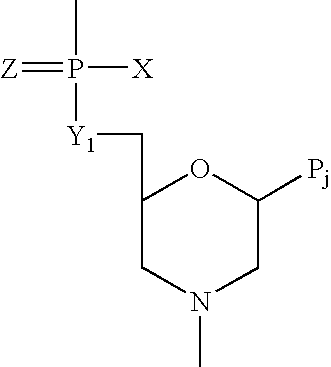Antisense antiviral compound and method for treating ssRNA viral infection
an antiviral and compound technology, applied in the field of antiviral compound and method for treating ssrna viral infection, can solve the problems of inability to specific treatment regimes for many viral infections, inability to immunize against these virulent viruses, and acute and severe symptoms, so as to improve the uptake of compound.
- Summary
- Abstract
- Description
- Claims
- Application Information
AI Technical Summary
Benefits of technology
Problems solved by technology
Method used
Image
Examples
example 1
Antisense Inhibition of Flaviviridae (Yellow Fever Virus) in vitro
[0289] Although an effective vaccine for yellow fever virus (YFV) has been available for many years, this virus continues to be a leading cause of hemorrhagic fever with mortality rates as high as 50%. Worldwide, there are 200,000 estimated cases of yellow fever (with 30,000 deaths) annually. Small numbers of imported cases also occur in countries free of yellow fever (WHO, Fact Sheet 100, 2001).
[0290] A PMO antisense oligomer targeted to the 5′ positive strand terminus of YFV (SEQ ID NO:49) was evaluated in a 4-concentration test. The standard CPE test used an 18 h monolayer (80-100% confluent) of Vero cells, medium was drained and each of the concentrations of PMO or scramble control sequence was added, followed within 15 min by virus or virus diluent. Two wells are used for each concentration of compound for both antiviral and cytotoxicity testing. The plate was sealed and incubated the standard time period requi...
example 2
Antisense Inhibition of Flaviviridae (Dengue Virus Serotypes1-4) in vitro
[0291] Dengue Fever / Dengue Hemorrhagic Fever (DF / DHF) has become a major global health problem over the past 20 years. Geographic distribution of the dengue virus (DEN), its mosquito vectors and the disease burden it causes continue to increase. The World Health Organization estimates that there are 50-100 million new infections yearly. DF / DHF is now a leading cause of hospitalization and death among children in southern Asia, and its incidence is sharply rising in the Americas. There is currently no vaccine or effective therapeutic. One requirement of a successful vaccine or therapeutic is that it be effective against all 4 human serotypes of DEN. The purpose of this study was to evaluate the efficacy and specificity of PMO that target the 5′ positive-strand terminal stem loop at inhibiting the replication of four serotypes of DEN in Vero cells in culture. The PMO was designed to target the sequence element i...
example 3
Antisense Inhibition of Coronaviridae (Porcine Reproductive and Respiratorv Syndrome Virus, PRRSV) in vitro
[0293] Porcine reproductive and respiratory syndrome (PRRS) is a contagious viral disease that is characterized by reproductive failure in sows and respiratory disease in young pigs. The causative agent, PRRSV, is a single-stranded RNA virus with genome organization similar to that of other members of the Coronaviridae. PRRS causes heavy economic losses to the swine industry though a vaccine has been widely used for years. Specific anti-PRRSV drugs are urgently needed as one of the integrated strategies to prevent and control PRRSV infection. A PMO (PRRSV-1a, SEQ ID NO: 109) that targets the 5′ positive strand terminal region of PRRSV was tested for its ability to inhibit viral replication as described below.
[0294] The first test was designed to determine whether the PRRSV-1a PMO could inhibit the development of virus-induced, cell pathogenic effect (CPE). ATCC CRL11171 cells...
PUM
| Property | Measurement | Unit |
|---|---|---|
| Tm | aaaaa | aaaaa |
| Tm | aaaaa | aaaaa |
| Tm | aaaaa | aaaaa |
Abstract
Description
Claims
Application Information
 Login to View More
Login to View More - R&D
- Intellectual Property
- Life Sciences
- Materials
- Tech Scout
- Unparalleled Data Quality
- Higher Quality Content
- 60% Fewer Hallucinations
Browse by: Latest US Patents, China's latest patents, Technical Efficacy Thesaurus, Application Domain, Technology Topic, Popular Technical Reports.
© 2025 PatSnap. All rights reserved.Legal|Privacy policy|Modern Slavery Act Transparency Statement|Sitemap|About US| Contact US: help@patsnap.com



